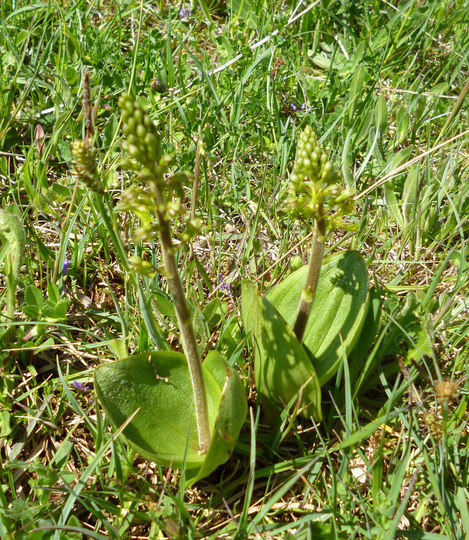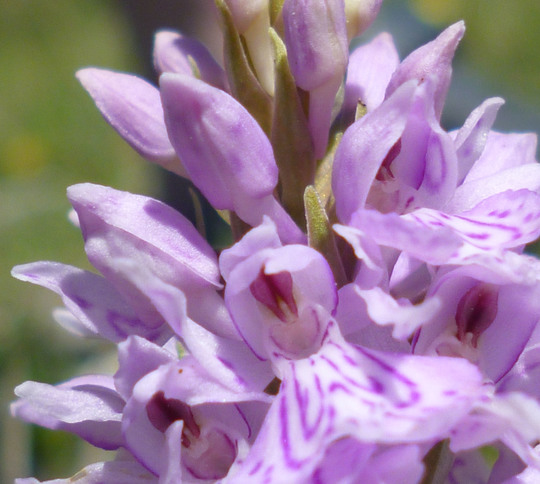A little bit of all sorts.
By seaburngirl
9 comments
This blog is a little bit of all sorts, plants doing well in the garden, wild flowers, and a few moths.
I went with Victoria to do a Butterfly Transect at a disused chalk quarry in North Yorks last Wednesday. It was very hot and sunny, perfect butterfly weather. I wandered behind her so as not to disturb any insects so had a chance to look at the flowers.
A general view of the longer grassed area.

This is common milkwort and a rich source of nectar.

Crosswort another good food plant.

Out in the open I found these Twayblades, a native green orchid that is happy in the open or under trees. The leaves were 6 inches long.

I had to look this up when I got home. Lady’s bedstraw: I hadn’t realised how tall it was [18"]. The flowers buds are forming and I will go back to see it in 2 weeks time.

In the areas where there is less topsoil, there is lots of wild thyme and the bees and flutterbys were very interested in it.

I also found plenty of Early purple orchids but didn’t find the thistle broomrape on the transect path. [You have to follow a specific route].
Early purple orchid in bud, with the characteristic spotted leaves.

Close up of the flower of an open e.p. orchid.

Spotted this Mother Shipton Moth. If you look at the pattern on the wings they look a bit like a witch’s head with a hooked nose.

Hubby and I went for a motor bike ride this Tuesday and we bimbled about and had a rest stop at Wykeham Woods. On the wild parsley and nettles there was this insect, didn’t recognise it at all but its antennae were really long. Described it to Victoria and she said Green longhorn moth.

So that is 2 day flying moths I’ve managed to ‘capture’. There are many more day flying moths than people realise. Also many don’t really look like your typical moth.
One of the nocturnal moths trapped this week in the garden. A rustic shoulder knot.

And flowers in the garden:
First flower on Clematis Rebbeca, lots more buds to follow.

A bud about to burst on Papaver orientalis ‘Allegro’, love the stiff hairs on the sepals.

Grown from HPS seed this is Tagettes patuia. There were 9 plants now 3 thanks to the various molluscs in the borders.

That’s enough for tonight, off to bed after a quick cuppa.
 12 Jun, 2021
12 Jun, 2021 9 likes
9 likes
Previous post: Just those little jobs.
Next post: Sunshine effects
Comments
Fascinating blog., SBG. The wild flowers look like they will be a rich source of food for the insects. It must be a very wildlife-friendly habitat. The Green Longhorn moth is a little beauty.
Your garden plants are coming on apace. Brilliant pic. of the poppy!
13 Jun, 2021
I love the native wildflowers. You have quite a varied pallet orchids- milkwort. All very interesting.
13 Jun, 2021
thank you all. The chalklands have a very rich and varied flora Bathgate and although it makes my garden alkaline it is worth it.
The chalkland flowers support an amazing range of insects and the food chains are quite complex as a result.
13 Jun, 2021
Loved your blog and seeing your lovely pics, Eileen.
Such an interesting read and I’ve learned some more about our native plants and insects! The close up of the unopened poppy is fab!
13 Jun, 2021
Lovely selection of wild flowers. I grow the Lady's Bedstraw in the hope that it will attract the Humming-Bird Hawk Moth to lay her eggs. She also likes Red Valerian which I also grow up on the field - no harm in hoping! I am also into various Vetch's at the moment and grow several, but being a wild plant they are really attractive to the wild rabbits in the garden and also my Peacocks - live in hope for them too.
13 Jun, 2021
What an interesting outing Eileen! The Green Longhorn moth is amazing. Does Victoria know why its feelers are so long? Love the Tagetes and the poppy photos. You seem to get a bigger range of species on the chalk - especially the blue ones, or is it my imagination?
Honeysuckle thank you for the info re the hawk moth. we have lots of red valerian in some of the coastal places - will look out for it!
13 Jun, 2021
the blues are more likely to be on chalkland as their food plants are chalk species.
the holly blue needs holly and ivy but most other blues like the common dont.
We had humming bird hawkmoths on honeysuckle and hedge woundwort last year. they are more likely to be day flying ones too.
no idea why the longhorns have such long antennae, may be a 'look at me' type thing or better at detecting scent. I asked her and she said no idea.
13 Jun, 2021
What an interesting blog with some smashing pics. I think we sometimes forget all our cultivated flowers began, in someway, as wild flowers.
14 Jun, 2021
Recent posts by seaburngirl
- Not my other garden!
28 Mar, 2025
- wont be sorry to see the back of January!
31 Jan, 2025
- farewell 2024
31 Dec, 2024
- Seasons Greetings
22 Dec, 2024
- Went up home.
3 Dec, 2024
- Some sad news
20 Jul, 2024
Members who like this blog
-
Gardening with friends since
28 Feb, 2019 -
Gardening with friends since
28 Feb, 2011 -
Gardening with friends since
1 Oct, 2013 -
Gardening with friends since
2 Feb, 2019 -
Gardening with friends since
29 May, 2013 -
Gardening with friends since
31 Mar, 2010 -
Gardening with friends since
9 Mar, 2012 -
Gardening with friends since
9 Aug, 2009 -
Gardening with friends since
5 May, 2010


Nice to see the wild flowers, B and I always looked for them wherever we went.
Interesting to see the moths, there are so many different ones and I didn't realise so many flew in the daytime.
13 Jun, 2021